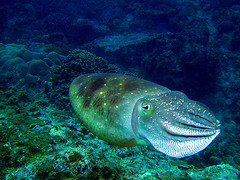Cuttlefish have three hearts which pump blood with shades of green and blue through their veins. Cuttlefish have ink and they are caught for food. But the most fascinating fact is: Cuttlefish can rapidly change their skin color. Among others this is used to camouflage them from predators. They adjust their skin color to the ground below them even though they are colorblind!

Recent researches about color blindness and contrast perception in cuttlefish at the Marine Biological Laboratory have approved this observation.
The next logical step for scientists now is to solve the puzzle how these creatures are nevertheless so good at comouflage themselves.
To find out more about the color blindness of cuttlefish the team around Lydia M. Mäthger used two different types of checkerboards to test their color vision in combination with a change of their body pattern.
- Gray – Green. One green shade, matched to the maximum absorption wavelength of cuttlefish, was combined with 16 different shades of gray. As supposed some shades of gray couldn’t be distinguished from the green by the cuttlefish, which didn’t adapt the body pattern. Experiment one was successful.
- Blue – Yellow. A checkerboard of blue and yellow matching in intensity was used for the second experiment. The skin color of the test species didn’t change either and therefore experiment two was also successful.
Even though cuttlefish have one of the most developed vision system and can even perceive the polarity of light, this experiments show that they are definitely suffering from color blindness.
The research paper closes with the following words about colorblind camouflage.
In shallow depths of water, broad-spectrum sunlight is available and consequently colored object in the natural environment will appear colorful. At greater depths, the composition of daylight becomes increasingly restricted to the bluegreen parts of the spectrum and the environment loses its colorful appearance. In this light environment, camouflage by intensity matching may be highly effective. Certainly, cuttlefish have broadband light reflectors that reflect the ambient wavelengths of light and may thus aid intensity matching at least at a localized level. However, the vexing question of how cuttlefish masters the task of camouflage in chromatically rich environments, such as those found at shallow depths of water, remains to be answered.
Further readings:
Cuttlefish Masters of Disguise Despite Colorblindness
Color blindness and contrast perception in cuttlefish (pdf)
Wikipedia: Cuttlefish
